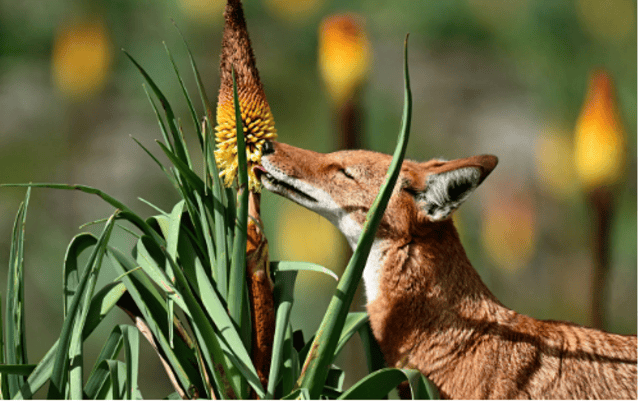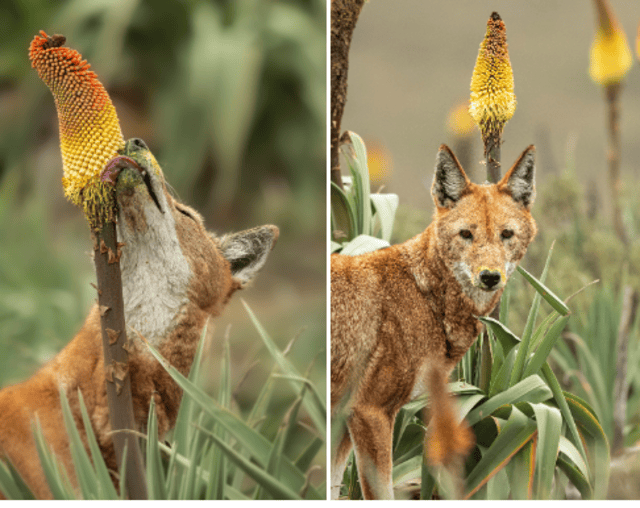 Sweet Surprises in Ethiopia’s Highlands: The Rare Ethiopian Wolf Pollinates in Style – Discover the Magic of Bale Mountains. (Photo: The Ethiopian wolf conservation program)
Sweet Surprises in Ethiopia’s Highlands: The Rare Ethiopian Wolf Pollinates in Style – Discover the Magic of Bale Mountains. (Photo: The Ethiopian wolf conservation program)
Tadias Magazine
November 24th, 2024
TADIAS (New York) – Ethiopia, often referred to as the Roof of Africa, is home to a stunning array of wildlife and breathtaking landscapes found nowhere else on Earth. From the ancient remains of Lucy, our earliest human ancestor, to the peaks of the Simien and Bale Mountains, the country’s natural wonders continue to captivate scientists, adventurers, and nature enthusiasts alike.
Among its unique inhabitants, the Ethiopian wolf, or Simien fox, stands out as a true symbol of the country’s rich biodiversity. The rarest canid in the world and Africa’s most endangered carnivore, the Ethiopian wolf is found only in the high-altitude grasslands of Ethiopia. With fewer than 500 individuals remaining, this elusive predator has adapted to life in the Afroalpine habitat, hunting rodents and navigating some of the harshest terrains.
Yet, this week, the Ethiopian wolf made headlines not for its hunting prowess but for an unexpectedly sweet discovery: it has been spotted licking nectar from Ethiopian red hot poker flowers. This behavior, documented by researchers from the Ethiopian Wolf Conservation Program and the University of Oxford, marks the first recorded instance of a large carnivore feeding on nectar.
Sweet as Honey

(Photo: The Ethiopian wolf conservation program)
Imagine this elegant predator delicately sipping nectar from the fiery blooms of the red hot poker flower. While locals have long known about the flower’s sugary nectar—shepherd children in the Bale Mountains often enjoy it as a natural treat—scientists were thrilled to find wolves indulging in the same delicacy. Not only does this behavior showcase the wolf’s adaptability, but it also hints at a fascinating ecological role: pollination.
With their muzzles coated in pollen, these wolves may be helping the flowers reproduce, bridging the gap between predator and pollinator in a way never observed before. As Dr. Sandra Lai, a senior scientist at the Ethiopian Wolf Conservation Programme, aptly put it, this discovery highlights how much we still have to learn about these remarkable animals and their interactions with the ecosystem.
Why It Matters
Ethiopia is home to an extraordinary array of endemic animals, including the Gelada baboon, Walia ibex, Black lion, and the Mountain nyala. Each species is a testament to the unique evolutionary story of the Ethiopian Highlands. However, many of these creatures, like the Ethiopian wolf, face threats from habitat loss, disease, and human encroachment.
The wolf’s newfound “sweet tooth” not only adds a delightful twist to its story but also underscores the importance of preserving Ethiopia’s Afroalpine habitats. These high-altitude landscapes are teeming with life, offering travelers an unparalleled glimpse into the beauty and diversity of Ethiopia’s natural world.
Visit the Roof of Africa
For those looking for an adventure, a trip to the Bale Mountains is a chance to witness these incredible animals in their natural habitat. Whether you’re trekking through the stunning alpine meadows or spotting rare wildlife like the Ethiopian wolf, it’s an experience that connects you to the heart of Ethiopia’s unique ecosystem.
So, the next time you see a red hot poker flower, remember: even the fiercest predators can have a soft spot for something sweet. Who knows? Perhaps this discovery will inspire more travelers to visit Ethiopia and contribute to the conservation of its rare and wonderful creatures.
—
Related:
Join the conversation on Twitter and Facebook

























